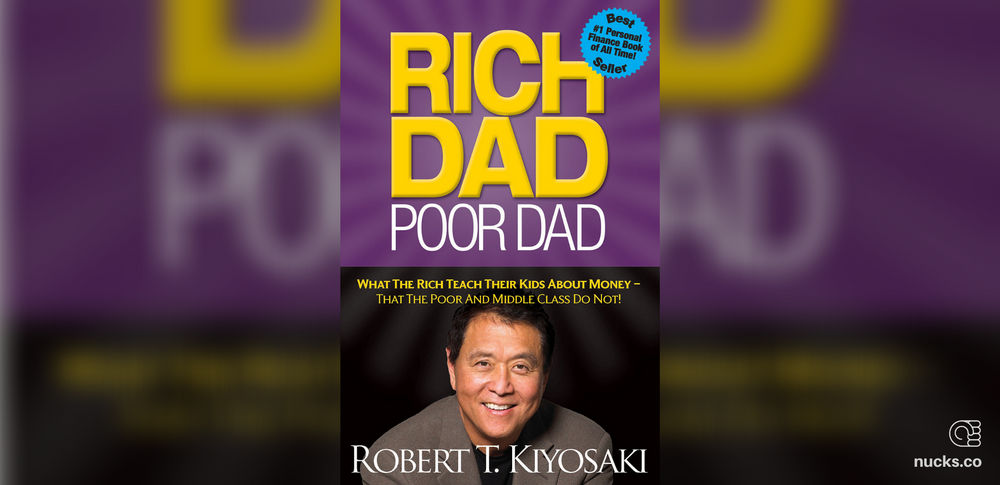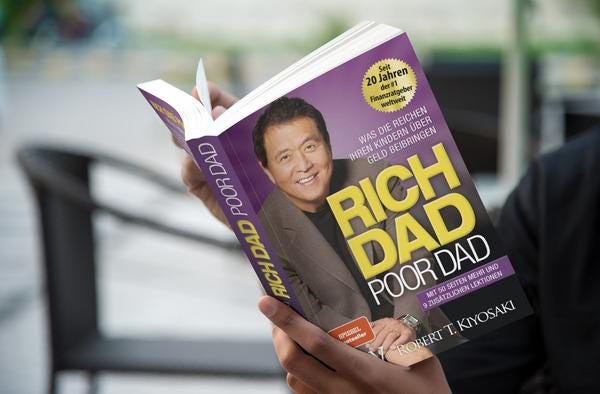Rich Dad Poor Dad is a book written by Robert Kiyosaki, which is considered to be a personal finance classic.
The book is written in the form of a memoir and highlights the experiences of Kiyosaki growing up with two dads – his biological father, whom he refers to as “poor dad,” and the father of his best friend, whom he calls “rich dad.”
The book is divided into 10 chapters, each of which highlights a specific lesson that Kiyosaki learned from his “rich dad.” In this article, we will go through the key lessons that are outlined in the book.

Lesson 1: The Rich Don’t Work for Money
The first lesson in the book highlights the difference in mindset between the “rich” and the “poor.” Kiyosaki explains that the “poor” tend to work for money, while the “rich” make money work for them. He points out that many people spend their lives working for a paycheck, but that this is not the path to financial freedom.
Instead, Kiyosaki suggests that people should focus on building assets that generate income. This could be anything from owning rental properties to starting a business. The idea is to create a source of passive income that can help to fund your lifestyle, without having to trade your time for money.
Lesson 2: Why Teach Financial Literacy?
The second lesson in the book highlights the importance of financial literacy. Kiyosaki argues that the reason many people struggle financially is that they are not taught about money and how it works. He points out that most people go through the education system without ever learning about things like investing, taxes, or financial planning.
Kiyosaki suggests that parents should take it upon themselves to teach their children about money. This includes things like explaining the difference between assets and liabilities, how to read financial statements, and the importance of investing for the future.
Lesson 3: Mind Your Own Business
The third lesson in the book focuses on the importance of entrepreneurship. Kiyosaki argues that starting a business is one of the best ways to achieve financial freedom. He explains that when you work for someone else, you are essentially building their business and helping them to achieve their goals.
In contrast, when you start your own business, you are in control of your own destiny. You have the freedom to create a business that aligns with your values and goals, and that can help you to achieve financial independence.
Lesson 4: The History of Taxes and the Power of Corporations
The fourth lesson in the book focuses on the power of corporations and the importance of understanding taxes. Kiyosaki argues that the wealthy use corporations to their advantage, as they are able to take advantage of tax breaks and deductions that are not available to individuals.
Kiyosaki suggests that people should take the time to understand the tax code and how it works. This includes things like understanding the difference between earned income and passive income, and learning about tax deductions that are available for things like business expenses and investment properties.
Lesson 5: The Rich Invent Money
The fifth lesson in the book highlights the importance of creativity and innovation in building wealth. Kiyosaki argues that the wealthy are not afraid to take risks and try new things. They are constantly looking for ways to create value and generate income.
Kiyosaki suggests that people should focus on developing their creativity and innovation skills. This includes things like learning how to solve problems, coming up with new ideas, and taking calculated risks.
Lesson 6: Work to Learn—Don’t Work for Money
The sixth lesson in the book emphasizes the importance of lifelong learning. Kiyosaki argues that the most successful people are those who are constantly learning and growing. They are always looking for new ways to develop their skills and knowledge.
Kiyosaki suggests that people should focus on learning valuable skills that can help them to build wealth. This could be anything from learning how to invest in stocks to developing a new business idea. The key is to focus on skills that will enable you to generate income and build wealth over the long term.
Lesson 7: Overcoming Obstacles
The seventh lesson in the book focuses on the importance of perseverance in achieving financial success. Kiyosaki argues that everyone faces obstacles and setbacks on the path to success, but it is those who are able to overcome these obstacles who ultimately achieve their goals.
Kiyosaki suggests that people should focus on developing a mindset of resilience and determination. This means being willing to take risks, face challenges, and learn from your mistakes. It also means being willing to persevere through difficult times and not giving up when things get tough.
Lesson 8: Getting Started
The eighth lesson in the book focuses on the importance of taking action. Kiyosaki argues that many people have great ideas and dreams, but they never take action to make them a reality.
He suggests that people should focus on taking small, actionable steps toward their goals. This could be anything from saving a small amount of money each week to starting a side business. The key is to take action and start making progress toward your goals.
Lesson 9: Still Want More? Here Are Some To Do’s
The ninth lesson in the book provides some practical advice for those who want to achieve financial success. Kiyosaki suggests that people should focus on developing a plan for achieving their goals, whether that is starting a business or investing in real estate.
He also suggests that people should focus on building a network of like-minded individuals who can support and encourage them on their journey. This includes attending networking events, joining clubs and organizations, and seeking out mentors who can provide guidance and advice.
Lesson 10: Final Thoughts
The final lesson in the book provides some closing thoughts on the importance of financial education and taking control of your financial future. Kiyosaki argues that anyone can achieve financial success if they are willing to learn and take action.
He suggests that people should focus on developing a mindset of abundance and possibility. This means believing that anything is possible if you are willing to work hard and take action.
In conclusion, Rich Dad Poor Dad is a book that provides valuable insights into the mindset and habits of the wealthy. It highlights the importance of financial literacy, entrepreneurship, and lifelong learning in achieving financial success. Rich Dad Poor Dad has been a highly successful book since its initial publication in 1997. It has sold over 40 million copies worldwide and has been translated into 51 languages.
The book provides practical advice and actionable steps that anyone can take to start building wealth and achieving their financial goals. Whether you are just starting out on your journey to financial freedom or are already well on your way, Rich Dad Poor Dad is a must-read book that will provide valuable insights and inspiration.



[…] Read also: Mastering the Rich vs Poor Mindset: Lessons from Rich Dad Poor Dad Classic […]